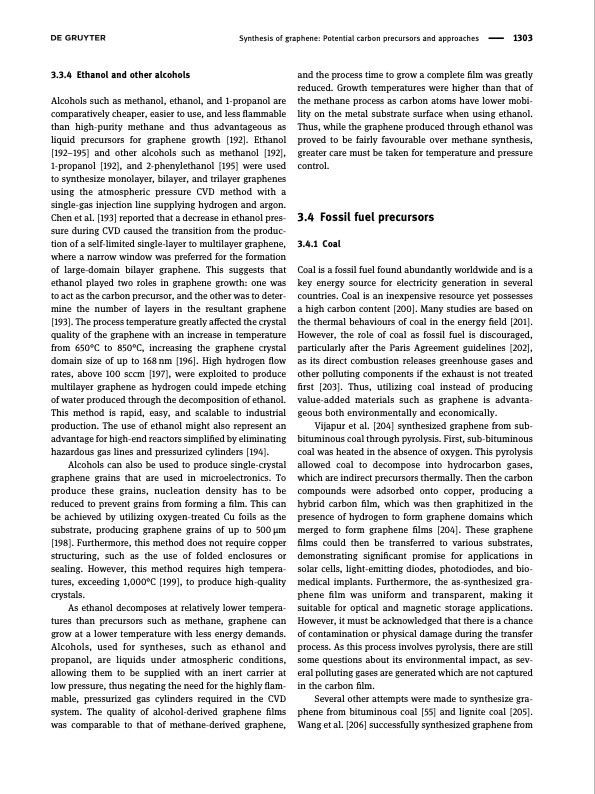
PDF Publication Title:
Text from PDF Page: 020
Synthesis of graphene: Potential carbon precursors and approaches 1303 3.3.4 Ethanol and other alcohols Alcohols such as methanol, ethanol, and 1-propanol are comparatively cheaper, easier to use, and less flammable than high-purity methane and thus advantageous as liquid precursors for graphene growth [192]. Ethanol [192–195] and other alcohols such as methanol [192], 1-propanol [192], and 2-phenylethanol [195] were used to synthesize monolayer, bilayer, and trilayer graphenes using the atmospheric pressure CVD method with a single-gas injection line supplying hydrogen and argon. Chen et al. [193] reported that a decrease in ethanol pres- sure during CVD caused the transition from the produc- tion of a self-limited single-layer to multilayer graphene, where a narrow window was preferred for the formation of large-domain bilayer graphene. This suggests that ethanol played two roles in graphene growth: one was to act as the carbon precursor, and the other was to deter- mine the number of layers in the resultant graphene [193]. The process temperature greatly affected the crystal quality of the graphene with an increase in temperature from 650°C to 850°C, increasing the graphene crystal domain size of up to 168 nm [196]. High hydrogen flow rates, above 100 sccm [197], were exploited to produce multilayer graphene as hydrogen could impede etching of water produced through the decomposition of ethanol. This method is rapid, easy, and scalable to industrial production. The use of ethanol might also represent an advantage for high-end reactors simplified by eliminating hazardous gas lines and pressurized cylinders [194]. Alcohols can also be used to produce single-crystal graphene grains that are used in microelectronics. To produce these grains, nucleation density has to be reduced to prevent grains from forming a film. This can be achieved by utilizing oxygen-treated Cu foils as the substrate, producing graphene grains of up to 500 μm [198]. Furthermore, this method does not require copper structuring, such as the use of folded enclosures or sealing. However, this method requires high tempera- tures, exceeding 1,000°C [199], to produce high-quality crystals. As ethanol decomposes at relatively lower tempera- tures than precursors such as methane, graphene can grow at a lower temperature with less energy demands. Alcohols, used for syntheses, such as ethanol and propanol, are liquids under atmospheric conditions, allowing them to be supplied with an inert carrier at low pressure, thus negating the need for the highly flam- mable, pressurized gas cylinders required in the CVD system. The quality of alcohol-derived graphene films was comparable to that of methane-derived graphene, and the process time to grow a complete film was greatly reduced. Growth temperatures were higher than that of the methane process as carbon atoms have lower mobi- lity on the metal substrate surface when using ethanol. Thus, while the graphene produced through ethanol was proved to be fairly favourable over methane synthesis, greater care must be taken for temperature and pressure control. 3.4 Fossil fuel precursors 3.4.1 Coal Coal is a fossil fuel found abundantly worldwide and is a key energy source for electricity generation in several countries. Coal is an inexpensive resource yet possesses a high carbon content [200]. Many studies are based on the thermal behaviours of coal in the energy field [201]. However, the role of coal as fossil fuel is discouraged, particularly after the Paris Agreement guidelines [202], as its direct combustion releases greenhouse gases and other polluting components if the exhaust is not treated first [203]. Thus, utilizing coal instead of producing value-added materials such as graphene is advanta- geous both environmentally and economically. Vijapur et al. [204] synthesized graphene from sub- bituminous coal through pyrolysis. First, sub-bituminous coal was heated in the absence of oxygen. This pyrolysis allowed coal to decompose into hydrocarbon gases, which are indirect precursors thermally. Then the carbon compounds were adsorbed onto copper, producing a hybrid carbon film, which was then graphitized in the presence of hydrogen to form graphene domains which merged to form graphene films [204]. These graphene films could then be transferred to various substrates, demonstrating significant promise for applications in solar cells, light-emitting diodes, photodiodes, and bio- medical implants. Furthermore, the as-synthesized gra- phene film was uniform and transparent, making it suitable for optical and magnetic storage applications. However, it must be acknowledged that there is a chance of contamination or physical damage during the transfer process. As this process involves pyrolysis, there are still some questions about its environmental impact, as sev- eral polluting gases are generated which are not captured in the carbon film. Several other attempts were made to synthesize gra- phene from bituminous coal [55] and lignite coal [205]. Wang et al. [206] successfully synthesized graphene fromPDF Image | Synthesis of graphene Potential carbon precursors

PDF Search Title:
Synthesis of graphene Potential carbon precursorsOriginal File Name Searched:
10-1515-ntrev-2020-0100.pdfDIY PDF Search: Google It | Yahoo | Bing
Salgenx Redox Flow Battery Technology: Power up your energy storage game with Salgenx Salt Water Battery. With its advanced technology, the flow battery provides reliable, scalable, and sustainable energy storage for utility-scale projects. Upgrade to a Salgenx flow battery today and take control of your energy future.
| CONTACT TEL: 608-238-6001 Email: greg@infinityturbine.com | RSS | AMP |